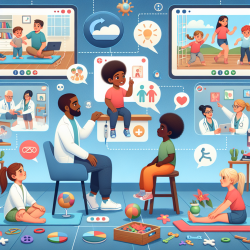Introduction
As a practitioner dedicated to creating the best outcomes for children, understanding the nuances of emerging infectious diseases (EIDs) is crucial. The research article "Gender Differences in Emerging Infectious Diseases" by Sharon Lewin and Marianne J. Legato provides valuable insights that can be transformative for your practice. This blog will explore how you can implement the findings from this research to enhance your therapy services, particularly in the context of online therapy platforms like TinyEYE.
Understanding Gender Differences in EIDs
The research highlights that gender differences significantly impact the spread, severity, and treatment outcomes of EIDs. For instance, physiological changes during pregnancy can alter decision-making regarding vaccinations and medications. Additionally, socio-economic factors such as poverty and educational inequities disproportionately affect women, making them more vulnerable to diseases.
Key Findings and Their Implications
Here are some key findings from the research and their implications for your practice:
- Pregnancy and EIDs: Pregnant women are often at higher risk due to physiological changes. This necessitates tailored therapeutic approaches that consider the unique needs of pregnant clients.
- Socio-economic Factors: Women in lower socio-economic strata are more susceptible to EIDs. Understanding these factors can help you develop more inclusive and effective therapy plans.
- Gender-specific Symptoms: Some EIDs manifest differently in men and women. Being aware of these differences can improve your diagnostic accuracy and treatment efficacy.
Implementing Research Findings in Your Practice
To leverage these insights, consider the following strategies:
- Customized Therapy Plans: Develop therapy plans that account for gender-specific risks and symptoms. For example, if you are working with pregnant women, ensure that your therapy sessions include discussions about the unique challenges they face.
- Inclusive Communication: Use inclusive language and communication strategies that consider the socio-economic backgrounds of your clients. This can make your therapy sessions more effective and relatable.
- Data-Driven Decisions: Utilize data to track the progress of your clients and make informed decisions. This approach can help you identify patterns and tailor your therapy sessions accordingly.
Encouraging Further Research
While the findings from this research are invaluable, there is always room for further exploration. Encourage your colleagues and peers to delve deeper into the topic of gender differences in EIDs. Collaborative research can lead to more comprehensive solutions and improved outcomes for all clients.
Conclusion
Understanding and implementing the findings from the research on gender differences in emerging infectious diseases can significantly enhance your practice. By developing customized therapy plans, using inclusive communication, and making data-driven decisions, you can create better outcomes for your clients.
To read the original research paper, please follow this link: Gender Differences in Emerging Infectious Diseases.










